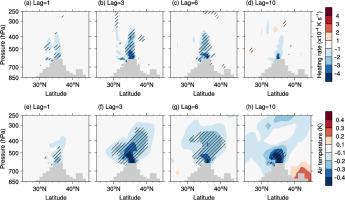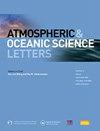青藏高原夏季极端积雪对局地大气的亚季节影响
IF 3.2
4区 地球科学
Q3 METEOROLOGY & ATMOSPHERIC SCIENCES
引用次数: 0
摘要
由于青藏高原的高海拔和寒冷气候,西部地区在夏季保留了广泛的积雪,在短短几天的时间内可以表现出快速的变化。本文利用数值实验研究了夏季亚季节尺度下青藏高原极端积雪事件的大气响应。结果表明,该时期TPSC的亚季节变化对局外大气环流和温度的影响有限。然而,当地地表能量和大气温度对积雪增加表现出快速的冷却响应。具体而言,青藏高原西部积雪增加导致地表反照率急剧上升,导致地表能量减少,局部地表至350 hPa的绝热升温速率呈负响应。这种负的非绝热加热响应随后导致地表和上覆大气温度下降。温度响应仅限于青藏高原西部,并从地表垂直延伸至350 hPa左右。这些极端的TPSC事件及其相关的大气影响发生在两周的时间尺度内。摘要青藏高原海拔高, 气候寒冷, 其西部地区在夏季仍有积雪覆盖, 且积雪变化可能在数日内迅速发生. 本文通过数值试验研究了大气对夏季青藏高原极端积雪事件的次季节响应. 结果表明, 尽管极端积雪事件对非局地大气环流及温度的影响有限, 但局地地表能量收支和大气温度对积雪增加表现出快速的冷却响应. 具体而言, 青藏高原西部积雪增加会导致地表反照率迅速上升, 从而减少地表能量输入. 此变化引发了局地地表至350 hPa高度的非绝热加热率的负异常响应,进而导致地表及上空大气温度下降。350 hPa, 350 hPa, 350 hPa上述夏季青藏高原极端积雪事件及其大气影响发生在两周时间内.本文章由计算机程序翻译,如有差异,请以英文原文为准。

Subseasonal impact of extreme Tibetan Plateau snow cover on the local atmosphere in summer
Due to the high elevation and cold climate of the Tibetan Plateau, the western region retains extensive snow cover during the summer, which can exhibit rapid variability over the course of just a few days. This study utilizes numerical experiments to investigate the atmospheric response to extreme Tibetan Plateau snow cover (TPSC) events on a subseasonal timescale during summer. The results indicate that the subseasonal variations in TPSC exert limited impact on nonlocal atmospheric circulation and temperature during this period. Nevertheless, local surface energy and atmospheric temperature exhibit rapid cooling responses to increased snow cover. Specifically, an increase in snow cover over the western Tibetan Plateau leads to a sharp rise in surface albedo, resulting in a reduction in land surface energy and a negative response in the diabatic heating rate from the surface to 350 hPa locally. This negative diabatic heating response subsequently causes a decline in both surface and overlying atmospheric temperatures. The temperature response is confined to the western Tibetan Plateau and extends vertically from the surface to approximately 350 hPa. These extreme TPSC events and their associated atmospheric impacts occur within a two-week timescale.
摘要
青藏高原海拔高, 气候寒冷, 其西部地区在夏季仍有积雪覆盖, 且积雪变化可能在数日内迅速发生. 本文通过数值试验研究了大气对夏季青藏高原极端积雪事件的次季节响应. 结果表明, 尽管极端积雪事件对非局地大气环流及温度的影响有限, 但局地地表能量收支和大气温度对积雪增加表现出快速的冷却响应. 具体而言, 青藏高原西部积雪增加会导致地表反照率迅速上升, 从而减少地表能量输入. 此变化引发了局地地表至350 hPa高度的非绝热加热率的负异常响应, 进而导致地表及上空大气温度下降. 气温响应主要局限于青藏高原西部, 并且从地表垂直延伸至约350 hPa高度. 上述夏季青藏高原极端积雪事件及其大气影响发生在两周时间内.
求助全文
通过发布文献求助,成功后即可免费获取论文全文。
去求助
来源期刊

Atmospheric and Oceanic Science Letters
METEOROLOGY & ATMOSPHERIC SCIENCES-
CiteScore
4.20
自引率
8.70%
发文量
925
审稿时长
12 weeks
 求助内容:
求助内容: 应助结果提醒方式:
应助结果提醒方式:


